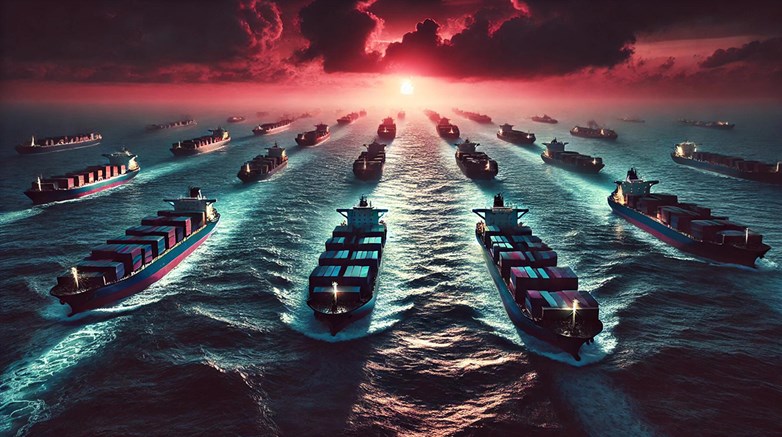In a move to intensify economic pressure on Russia, European Union envoys have agreed on a new sanctions package targeting Moscow’s clandestine fleet of oil tankers, commonly referred to as “ghost fleets.” These vessels operate in defiance of international sanctions, enabling Russia to maintain the flow of its oil exports despite Western restrictions.
The sanctions, announced by Hungary’s EU presidency, aim to disrupt the activity of approximately 50 aging and illegally operated ships. These vessels, often in poor condition, play a key role in Russia’s efforts to circumvent the $60 per barrel price cap imposed by the G7 on Russian seaborne crude oil in 2022. The fleet has become an essential asset for Moscow, ensuring steady revenues amid global isolation and a tightening grip from sanctions.
How the Ghost Fleets Operate
These shadow fleets employ various strategies to evade detection and sanctions. Some ships switch off tracking devices, falsify cargo documentation, or engage in ship-to-ship transfers in international waters to mask the origin of the oil. This covert network facilitates the movement of sanctioned oil to willing buyers in countries that continue to support Russia economically or militarily, thereby avoiding Western efforts to constrain Moscow’s revenue streams.
John Kilduff, a partner at Again Capital, remarked on the renewed global focus on clamping down on such illicit flows, which could tighten global crude supplies. Despite this, he noted, the broader market faces balancing challenges, especially with weaker demand in key economies like China.
The EU’s Broader Sanctions Strategy
This latest round of sanctions marks the 15th package imposed by the EU since the onset of Russia’s invasion of Ukraine in February 2022. The measures have already targeted key sectors such as energy, banking, and diamond mining, alongside asset freezes and travel bans on Russian officials and lawmakers. Over 2,300 individuals and entities are now subject to EU restrictions.
As part of the new package, the EU intends to penalize officials, companies, and organizations assisting Russia in circumventing export restrictions to bolster its military capabilities. The full list of targeted individuals and entities will be revealed in the EU’s official legal journal after formal adoption by foreign ministers.
Global Market Impacts
The announcement of the sanctions has sent ripples through global oil markets. Brent crude futures rose $1.33 to $73.52 per barrel, while U.S. West Texas Intermediate crude climbed $1.70 to $70.29. The sanctions threaten to tighten global crude supplies, even as producers’ group OPEC+ grapples with weak demand and non-OPEC supply growth.
OPEC+, which includes Russia, has recently scaled back plans to raise output, citing challenges such as low Chinese demand and supply growth outside the cartel. However, with China’s latest pledge to adopt a looser monetary policy in 2025, there is optimism that demand might recover in the world’s largest oil importer.
U.S. Sanctions and the Kremlin’s Response
On the other side of the Atlantic, the Biden administration has signaled a willingness to explore additional measures to curb Russia’s oil revenues. Treasury Secretary Janet Yellen emphasized the need for creative strategies to further reduce global demand for Russian oil and curtail Moscow’s ability to fund its war efforts.
The Kremlin, meanwhile, accused the U.S. of attempting to complicate bilateral relations with these measures. Russia continues to rely on its ghost fleets and allied nations to sustain its oil exports, highlighting the intricate geopolitical and economic battle at play.

How Russia’s Ghost Fleets Operate As A Strategic Asset For Selling Sanctioned Oil
When the European Union imposed an embargo on Russian oil in 2022 and capped prices on Russian hydrocarbon products in 2023, the Western bloc aimed to sever a vital revenue stream fueling Moscow’s war in Ukraine.
However, Russia has countered with an extensive network of clandestine vessels, aptly dubbed the “ghost fleet,” which now operates as a crucial lifeline for circumventing sanctions.
How Large is the Fleet?
The ghost fleet has grown exponentially since the onset of the Ukraine war. Initial estimates pegged its size at around 400 to 600 vessels, but as of late 2023, the analytics firm Vortexa calculated that over 1,600 vessels had engaged in opaque trading since January 2021. This includes more than 1,000 tankers transporting Russian crude oil.
Adding to the complexity, a subset known as the “gray fleet” has emerged, consisting of vessels whose ownership and sanctions compliance are ambiguous. Together, the dark and gray fleets now account for a staggering percentage of the global maritime oil trade, with the dark fleet alone making up 10% of the wet cargo fleet.
The Operations of Ghost Fleets
These fleets operate outside the purview of standard maritime regulations and Western oversight. Characteristics of the ghost fleets include –
—Opaque Ownership: Many of these ships are registered under shell companies in jurisdictions with lenient disclosure requirements, making ownership hard to trace.
—-Frequent Name and Flag Changes: Vessels often switch names and flags to obscure their identities, a tactic that complicates tracking.
—-Evasive Tactics: Ships turn off transponders, conduct ship-to-ship transfers in remote waters, and falsify cargo documentation to avoid detection.
The scale and sophistication of these tactics have allowed Russia to continue exporting oil despite sanctions, ensuring substantial revenues flow back to Moscow.
Historical Context and Strategic Importance
The concept of a shadow fleet is not new. Similar networks have been used by other sanctioned nations, including Iran, North Korea, and Venezuela, to sustain their economies and fund activities ranging from nuclear programs to insurgencies. For Russia, these fleets are not just an economic tool but a geopolitical weapon, ensuring oil revenue continuity despite international isolation.

Why the Ghost Fleet is a Threat
The proliferation of ghost fleets poses significant challenges to maritime safety risks. Many vessels in the fleet are aging and poorly maintained, increasing the risk of accidents, oil spills, and environmental disasters.
The network undermines global sanctions regimes, enabling Russia to fund its war efforts and destabilize international order. The fleet also enables economic disruption by manipulating global oil markets, affecting prices and availability.
The Global Response
The EU, G7, and allied nations are ramping up efforts to counter the shadow fleet’s activities. On October 17, 2023, the UK announced its fourth package of sanctions, barring 18 additional tankers from British ports and maritime services, including insurance. Despite these measures, enforcement remains a formidable challenge due to the fleet’s elusive nature and the lack of a centralized global maritime police force.
How Many Ghost Ships Are Out There?
Estimates vary widely, but by late 2023, analysts were suggesting that Russia’s ghost fleet had swollen to staggering proportions.
Commodity trading firms and maritime analytics companies placed the count between 1,400 and 1,600 vessels. This includes both “dark vessels” that operate entirely off the radar and the “gray fleet,” which skirts compliance while keeping ownership opaque.
Together, these fleets represent nearly 20% of the global tanker capacity for crude oil—a sobering statistic.
Shifts in Maritime Traffic
Since the Ukraine conflict, tanker traffic patterns have drastically changed. Russian crude oil once primarily bound for Europe and the U.S. now finds its way to India, China, and Morocco. Ship-to-ship transfers, often near Greece and Morocco’s coasts, obscure the cargo’s final destination. The use of “flags of convenience”—from countries like Gabon, Panama, and Liberia—has surged, with Gabon emerging as a haven for dark vessels.
Can They Be Stopped?
Despite mounting concerns, international law presents significant obstacles to combating ghost fleets. The United Nations Convention on the Law of the Sea (UNCLOS) grants broad rights to ships for “innocent passage” through territorial waters, provided they adhere to basic safety and environmental standards. Coastal states have limited authority to act unless vessels pose immediate threats, such as oil spills.
In exclusive economic zones (EEZs), the problem becomes even more complex, as nations lack legal jurisdiction over the vessels themselves. Any intervention, such as detaining a shadow vessel, risks leaving a problematic ship—and its crew—in the country’s waters indefinitely, an outcome most governments seek to avoid.
The Last Bit
The ghost fleets represent a strategic triumph for Russia, enabling it to sustain oil revenues while bypassing Western sanctions. However, they also point to vulnerabilities in global maritime governance. Without a unified international effort, these fleets will likely continue to grow, creating further economic, safety, and environmental risks.
As Western nations tighten sanctions and Russia adapts, the ghost fleets will remain a critical and contentious element of global energy and geopolitics.
Can the world keep pace with this evolving maritime shadow network? Or will it serve as a blueprint for other sanctioned nations seeking to navigate the global economy’s cracks? The answer, for now, remains elusive.















